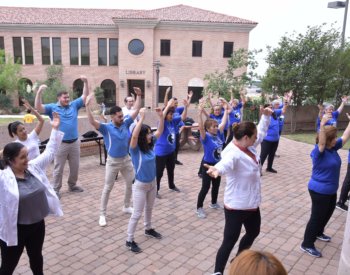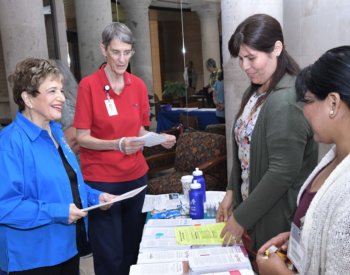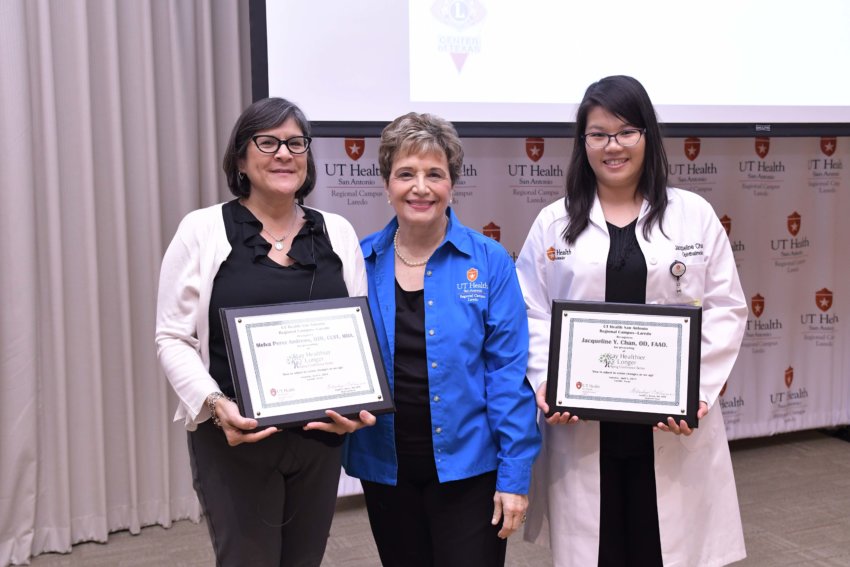LAREDO (April 16. 2019) ― It was standing room only at the Laredo Regional Campus of UT Health San Antonio for a community health fair and educational program focusing on vision changes in elders.

“We had a great turnout,” said Regional Dean Gladys Keene, M.D., describing the April 6 event. “We had more than 200 people here getting health screenings, learning about gardening and Tai Chi, and hearing from our guest speakers about what people can do to preserve their vision as they get older.” The program is part of the Laredo Campus’ annual “Stay Healthier Longer” series.
The guest speakers were Jacqueline Chan, O.D., FAAO, and Melva Perez Andrews, M.B.A., OTR, CLVT, both from UT Health San Antonio. Dr. Chan is an optometrist, low-vision expert and assistant professor in the Department of Ophthalmology. Andrews is adjunct clinical assistant professor in the Department of Occupational Therapy. She has been working with low-vision patients for more than 15 years.
According to National Eye Institute Research, 3.3 million Americans age 40 and older are blind or have vision impairments. This figure is projected to reach 5.5 million by the year 2020. People age 80 and older make up 8% of the U.S. population, but account for 69% of blindness.
“There are many causes of low vision. The most common causes we see in our practice are macular degeneration, diabetic retinopathy, glaucoma, cataracts, and vision defects from brain injuries or strokes,” Dr. Chan said. A fellow in the American Academy of Optometry, Dr. Chan is director of the Lions Low-Vision Rehabilitation Center of Texas, located at UT Health San Antonio.
Macular degeneration
“One of the most serious eye diseases is age-related macular degeneration. It is the leading cause of blindness and vision impairment in Americans past the age of 60,” Dr. Chan explained. Macular degeneration affects the central area of the retina. Thirty percent of people older than 75 show signs of macular degeneration, and one-third of all patients with macular degeneration are legally blind, she explained.
Diabetic retinopathy
Diabetic retinopathy is the leading cause of blindness among working-age adults. It affects the blood vessels in the retina. About 1 in every 12 people with diabetes older than age 40 has diabetic retinopathy, she said.

Glaucoma
“Diabetes also is a major factor in glaucoma. These patients are twice as likely to get glaucoma,” Dr. Chan said. Glaucoma is a progressive eye disease that damages the optic nerves and causes vision loss. It also is the leading cause of blindness among African Americans.
Cataracts
Cataracts, however, are the leading cause of blindness worldwide. Cataracts cause 50% of mild vision impairment in the U.S. by clouding the lens inside the eye. Although cataracts can be removed and replaced with new artificial lenses that provide some vision improvement, there is no cure for some low-vision ailments.
How low-vision rehabilitation services can help
“A low-vision exam can maximize functional vision to help people reach their goals,” Dr. Chan said. “They are different from a regular eye exam in that they are more in-depth, focusing on the problems people are having.”
Andrews, an occupational therapist and certified low-vision therapist, said that vision rehabilitation can help people who struggle with reading, taking their medications, driving or recognizing faces, even when wearing glasses.
“After the low-vision exam, we use a team approach to educate patients and provide new strategies, skills, visual aids and low-vision technology to help them maximize their vision. When a patient is visually impaired, they may be eligible for services and assistance through state and local nonprofit programs, and we can assist by coordinating care,” Andrews said.
Resources
In the state of Texas, a legally blind patient may be eligible for an income tax exemption, tuition exemption, disability license plate, placard application and free fishing license.
For more information about low-vision, low-vision exams, rehabilitation and resources, visit the Lions Low-Vision Rehabilitation Center of Texas.
The Lions Low-Vision Rehabilitation Center of Texas is supported in part by the Lions Sight Research Foundation.
# # #
For current news from the UT Health Science Center San Antonio, now called UT Health San Antonio™, please visit our online newsroom, like us on Facebook or follow us on Twitter.
# # #
The University of Texas Health Science Center at San Antonio, now called UT Health San Antonio®, is one of the country’s leading health sciences universities. With missions of teaching, research, healing and community engagement, its schools of medicine, nursing, dentistry, health professions and graduate biomedical sciences have produced 35,850 alumni who are leading change, advancing their fields and renewing hope for patients and their families throughout South Texas and the world. To learn about the many ways “We make lives better®,” visit www.uthscsa.edu.


